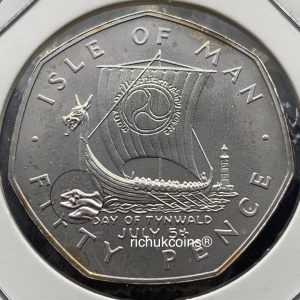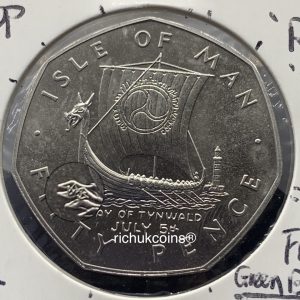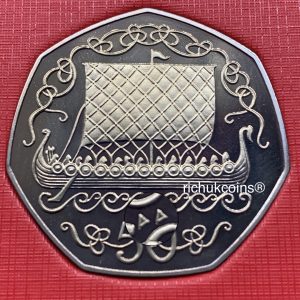Published on
Last Updated on:
Today, we are going to talk about so-called die marks, invented by the Pobjoy mint in 1973 on gold coins and presented on Isle of Man coins. They (the Mint, hereafter) have got the contract in 1972. A little bit background of the Pobjoy family, they had a airmotors company ltd and had strong background of engineering before stepping into this business. This business is very profitable like BBC Archive (2018) said a business without cash flow. According to MacKay (1978, p.63), “the first contract, with a value in excess of £5 million, came from the Bolivian Government, and was soon followed by similar contracts with the governments of the Isle of Man and Senegal.” How profitable is it, let us break it down. If you are familiar with financial sector like hedge fund managers, a rule of 2-20 with a value of £5 million works here, meaning 2% is for asset management fee and 20% of your profit on your asset.
A singular letter, for instance, A or B or C or D or E etc, is only used on precious metals like gold, then expanding on silver. The purpose of carrying a die mark on is to identify the particular die used in striking that coin. Now, let we have a look what singular die marks are, for the purpose of illustration of the die marks seen as follows:
- Ancient Hiberno-Norse lettering

Note: sequences are in alphabetical from A to E. A very special die mark ‘X’ was defaced personally by William Dawson then the Tynwald Treasurer in 1974. Base metals in BU finish grade have double letters in association with the Prefix A, and in proof finish grade also have two letters with the Prefix B. “[p.82]… The dies used in striking proof and uncirculated versions of coins in precious metals have a single letter beginning with B, C, D and so on. The first letter or letters in each group (i.e., AA, BB or B), was used on dies which struck coins on 14th July 1978 only, the First Day of Minting (FDM) (MacKay, 1978).”
At this point, we can understand a singular die mark has no particular meaning but just for coin traces in order for identifying a die used in striking that coin. Most importantly, it is the concept of FDM.
- D — left from 1978 (£1), right from 1979 (50p, Royal Visit) (Silver)
- E — left from 1978 (£1), right from 1979 (50p, Royal Visit) (Silver)
- F — left from 1978 (£1), right from 1979 (50p, Royal Visit) (Silver)






Note: £1 silver coins with a letter started in 1978, and it was the first pound coin in British decimalisation system. Given 1975 (50p) and 1976 (50p) in contrast, the two years had BU finish in perspex set only. However, the 1977 (50p) and 1978 (50p) ones were proof finish in velvet set only. The four sets mentioned here had no any die marks due to pre-1979. On the basis of the die marks D, E and F, at first glance, D die coin and E die coin they have a similar proof finish between the £1 coins ([D = E] > F). Secondly, E die coin has the best finish, and the lowest is F die coin among 50p coins where come from the Royal Visit IOM series (E > D > F). At this point, the F die letter it is understood to trace Satin Finish on coins either £1 or 50p.
Later on, to commemorating IOM £1 round coin on a base metal specifically Virenium, a 2-digit letter (BC) was revealed in 1978 as well. Based on information above, it has just been verified that Prefix B is equivalent to proof finish in grade (please see IOM £1 round coin or Die Marks BC article), this is a very solid point. This point also can be understood that a 2-digit letter is used to strike coins on base metals like virenium, copper-nickel (CN). Thirdly, it is understood that the sequence of C has the meaning of commemorative or celebrating by Tynwald.
From £1 coin below, you are able to see a). AA, BB and BC as a set and b). AA, AB, AC and AD as a subset from a).:
- AA from 1978 (£1) (Virenium, FDM)
- AA from 1978 (£1) (Virenium, FDM) & AB from 1978 (£1) (Virenium)
- AC from 1978 (£1) (Virenium) & AD from 1978 (£1) (Virenium)
- BB from 1978 (£1) (Virenium, FDM)
- BC from 1978 (£1) (Virenium, Special Commemorative type)







From 50p coin below, you are able to see:
- AA from 1979 50p coins (FDM)
- AB from 1979 50p coins
- AC from 1979 50p coins*
- AD from 1979 50p coins


Note: edge lettering noted.


Note: edge plain.


*Note: left one, it was for New York Show in 1980 and edge lettering noted. You see it right now because they just made this gap to fit in this one. left: library finish & right: prooflike finish.


Note: edge lettering noted.
Note: a base-metal coin like CN 50p coin associated with die mark started in 1979. But, 1979 it was really important the year to Tynwald. A very interesting point, pictures above show many different finish 50p coins under Prefix A. However, there is no any 50p coins under Prefix B in comparison to £1 coin.
Beyond this point, you are going to see a 2-same-digit die mark coin like BB, DD and AA.
- 1980 BB — IOM Xmas 50p coin (FDM)
- 1980 DD — IOM Proof set coin (FDM)*
- 1980 AA — IOM currency 50p coin (FDM)


Note: a very interesting set of two coins, because carrying the same die mark but different grades in finish. If a lower grade BB coin is considered FDM, what about BB in higher grade? And BC??? Can not see continuity. It is highly likely the Pobjoy own product. At this point, the BA die mark is making more sense now.

*Note:The BB has been used on commercial commemorative coins, the only choice left is to choose the DD. It is understood from citing on Krause book foot note that they declare the BC as diamond finish in grade not the BB or the DD. A question unsolved now what the correlation between the F die letter and No die letter (ND) finish?

Right now, you can clearly see that a group of 2-digit die marks indicates different finishes like BB, DD and FF have a superb finish in grade. Associated with different die marks, you are able to see different finishes on coins. It is hard to say the correlation among them, but, based on things we have known already, metrics [A, C, E] and [B, D, F] are created.
A C E
B D F
Reference
**BBC Archive (08, Oct 2018), #OnThisDay 1978, [Adapted on 15th, Nov 2018].
**MacKay, J.A. (1978), The Pobjoy Encyclopaedia of Isle of Man Coins and Tokens (2nd ed.). Surrey, England: The Pobjoy Mint.
#The End